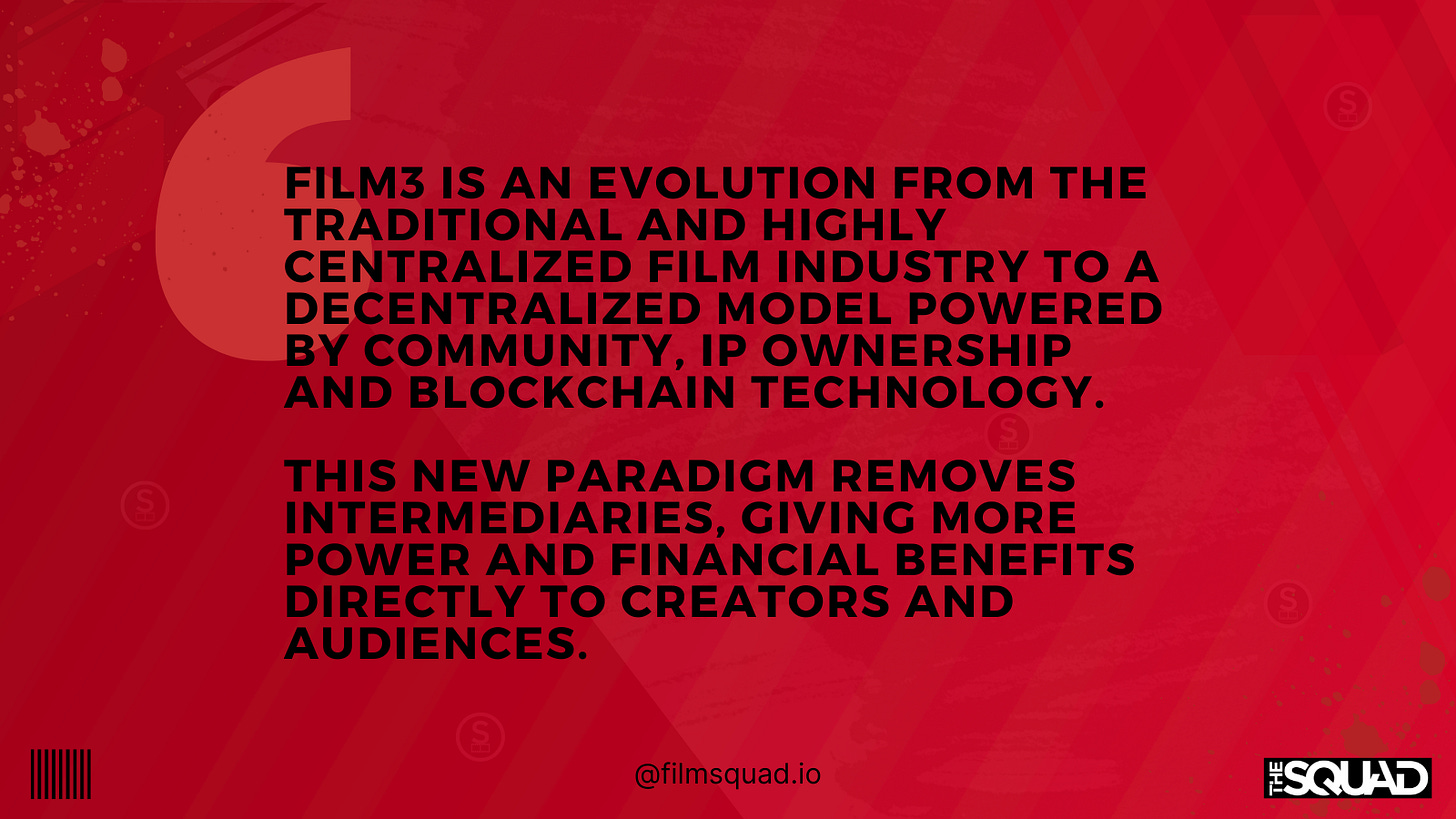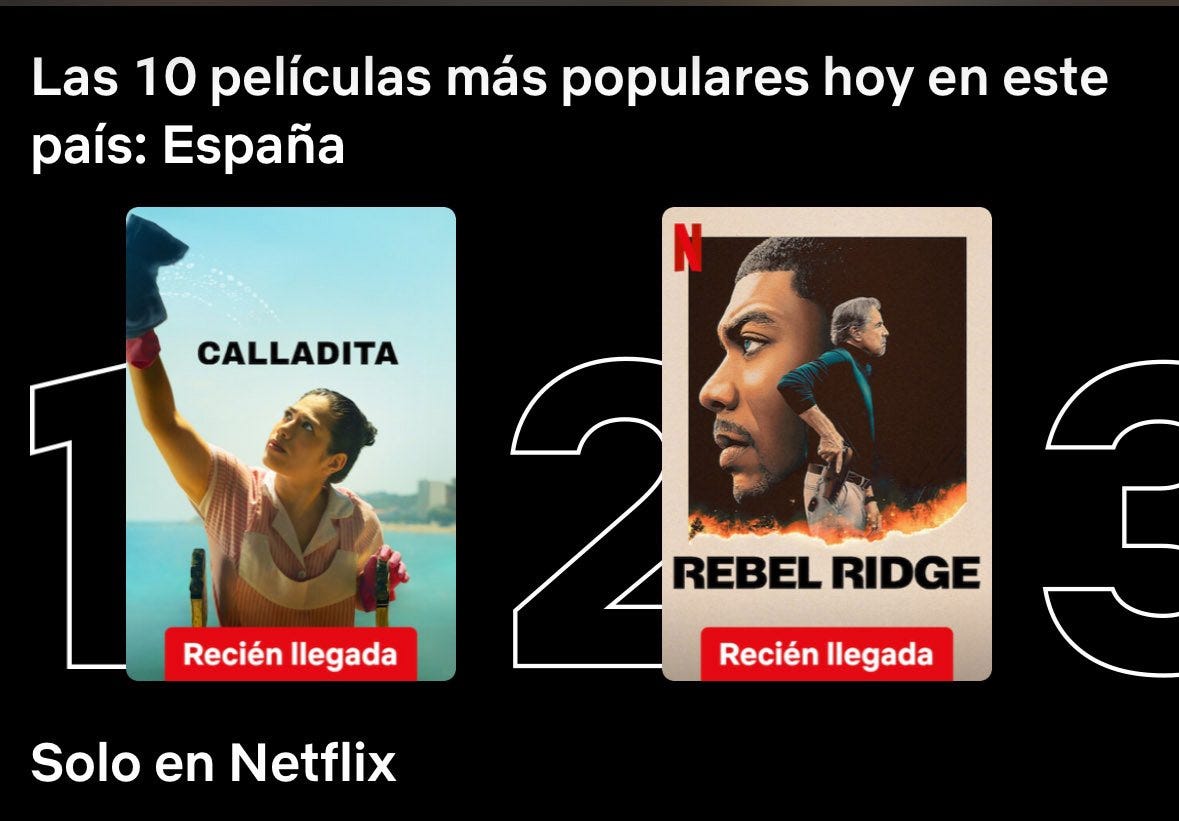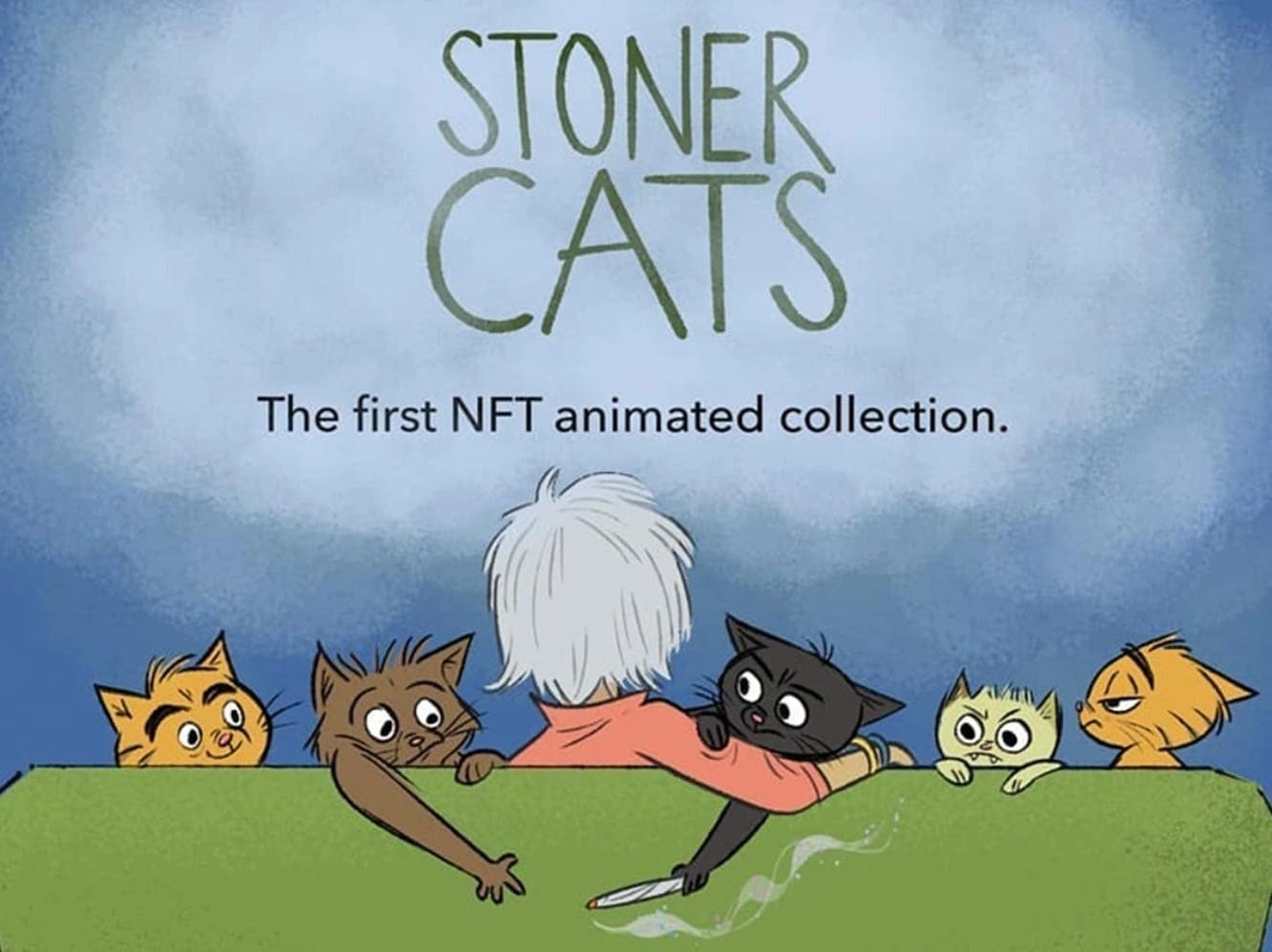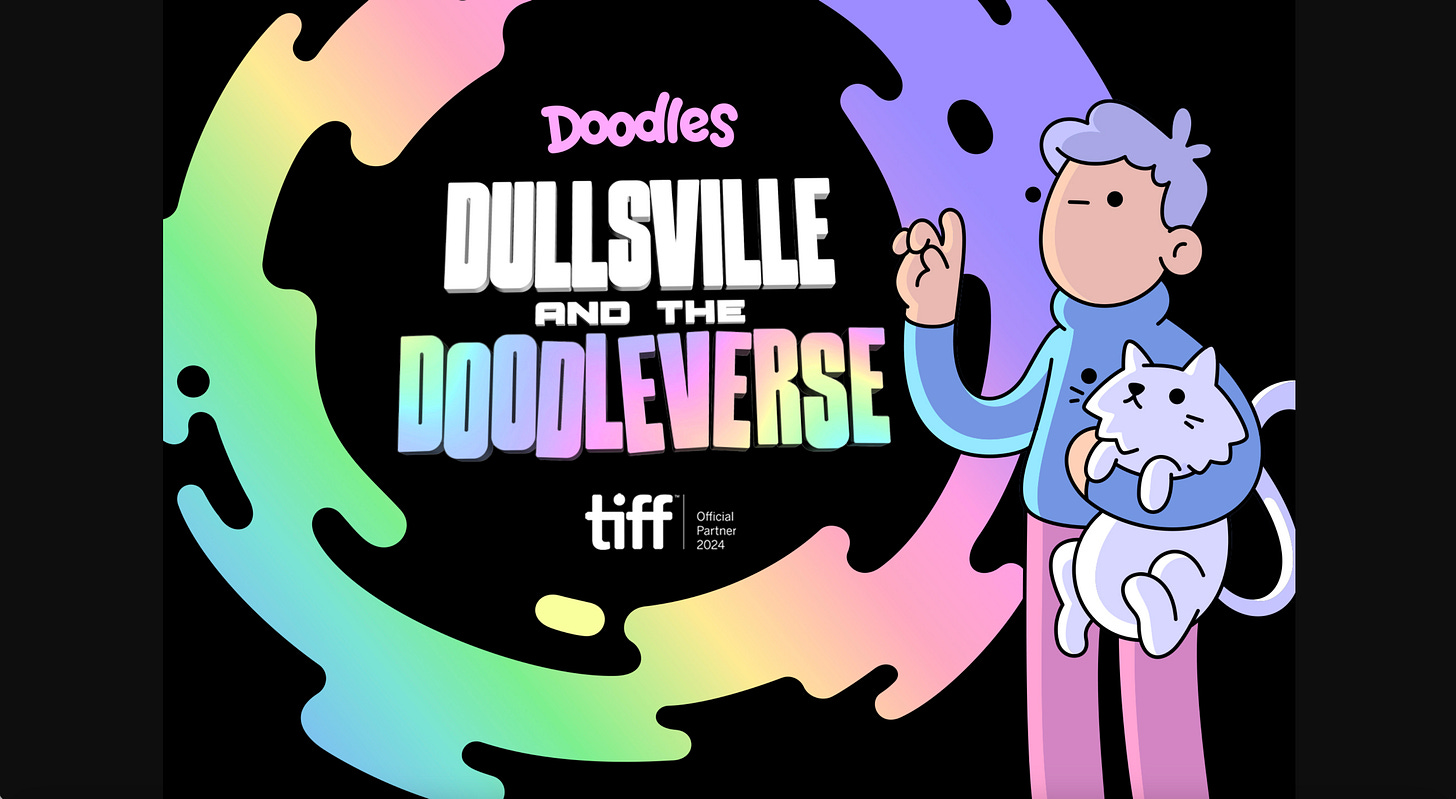Redefining IP Ownership in Entertainment
Blockchain and Beyond: A Creator’s Film3 Blueprint for Ownership
The entertainment industry is experiencing a seismic shift as Film3 redefines how creators own, control, and distribute their intellectual property (IP). Groundbreaking projects like David Bianchi’s Emmy nominated RZR from Gala Films, Miguel Faus’ NFT-funded CALLADITA reaching #1 on Netflix Spain, Doodles making waves at TIFF, and Claynosaurz partnering with Gameloft are only the beginning.
For those of us deeply embedded in this space, the writing was always on the wall. That’s why, since February 2021, I’ve worked with The Squad to champion a future where creators have the power to shape their own narratives — unshackled from the legacy Hollywood system. This vision first began to crystallize when I started talking about how Web3 would revolutionize the entertainment industry. This discourse would soon become the foundation of what we now know as Film3.
At the heart of this transformation is the concept of Intellectual Property (IP) ownership, a cornerstone of the Film3 business model.
My journey into crypto in 2015 was fueled by the quest for self-sovereignty, and in December 2020 when NFTs started to gain traction, it became evident that creators retaining control over their IP was the key to unlocking a new era of empowerment. As a filmmaker, I’ve witnessed too many colleagues pour their blood, sweat, and tears into projects, only to be forced into selling their rights to the lowest bidder, stripping them of control and future profits. This broken, unsustainable system leaves creators demoralized and powerless.
The Film3 model offers a game-changing alternative: creators maintain ownership of their IP, keep creative control, and dictate how their projects are developed, financed, and distributed.
Let’s unpack why this shift in IP ownership is so crucial for creators and the future of entertainment.
Understanding Intellectual Property (IP) in Entertainment
At the heart of any creative endeavor is Intellectual Property (IP), a legal framework that grants creators ownership over their original works. Whether it’s a film, musical composition, book, or invention, IP defines who controls the content and how profits are distributed. In the film industry, IP ownership is paramount—it determines who holds the rights to a story, characters, and future adaptations. Essentially, whoever owns the IP reaps the financial and creative rewards.
In the traditional Hollywood model, creators often find themselves surrendering their IP rights to studios in exchange for the funding, distribution, and marketing necessary to bring their projects to life. Unfortunately, this typically means that once a creator hands over their IP, they lose the right to influence its future — whether that’s deciding on sequels, licensing for merchandise, or broader content adaptations. The studios, as the new IP holders, control the lifecycle of the project and capture the lion’s share of the revenue.
This dynamic can be detrimental to filmmakers. Despite being the visionaries behind the projects, creators often receive minimal long-term financial benefits. Once the initial deal is made, the creator’s control and participation in the ongoing success of their work is largely diminished.
Example: George Lucas and Star Wars
A well-known example of the challenges with traditional IP ownership is George Lucas and his Star Wars franchise. In 2012, Lucas sold the rights to Star Wars to Disney for $4 billion. While Lucas was handsomely compensated, he relinquished all creative control over the universe he had built. Disney proceeded to produce a new trilogy of films, which, notably, did not involve Lucas’s input. Lucas has since expressed disappointment in the creative direction of the new movies, particularly how The Force Awakens diverged from his original vision.
This case is emblematic of how traditional Hollywood models often sideline the original creators once IP changes hands. Although Lucas created one of the most successful franchises in history, he no longer had a say in its ongoing development. For creators, this loss of autonomy can be disheartening and creatively stifling, even if the financial payout is substantial.
Challenges for Creators in Traditional Systems
The Star Wars example is not unique — across Hollywood, countless creators face similar dilemmas. For many, giving up IP is a necessary evil to fund and distribute their projects, but the long-term cost is steep. Not only do they lose out on residuals and merchandise revenue, but they also sacrifice the ability to guide their own artistic vision as their projects expand into sequels, TV spin-offs, or product lines.
In short, the traditional IP model favors the studios at the expense of creators. It locks filmmakers out of the financial and creative decisions that are crucial to the ongoing life and legacy of their work.
The Film3 Revolution: Redefining IP Ownership and Creator Empowerment
Film3 fundamentally reimagines the traditional entertainment model, empowering creators to maintain ownership of their intellectual property (IP) throughout the entire lifecycle of a project. This approach shifts the balance of power away from studios and back into the hands of creators, allowing them to take full control of the creation, distribution, marketing, and monetization of their work.
Unlike the traditional Hollywood system, where creators often have to sell their IP in exchange for funding or distribution, Film3 leverages blockchain technology to enable decentralized financing and distribution models. By utilizing smart contracts and NFTs aka Digital Collectibles, creators can directly engage with their community and audience, making them stakeholders in the project’s success. This creates a new ecosystem of transparency, trust, and equitable profit-sharing, where creators retain control over their projects while empowering their audience to participate in its success.
Additionally, Film3’s direct-to-consumer model enables creators to bypass the traditional gatekeepers of Hollywood and retain the lion's share of profits. Fans are not only supporters but active participants in promoting and supporting the content they believe in. This approach aligns the interests of creators and their communities, fostering a more inclusive and equitable future for entertainment.
At the core of Film3’s philosophy lies self-sovereignty: the idea that creators should own and control their intellectual property, utilizing community as the driving force for funding through marketing and distribution. This stands in stark contrast to traditional models, where creators are often forced to surrender their IP rights to studios in exchange for financing. Once relinquished, the rights and potential profits are handed over to the studio, leaving filmmakers without a say in how their work is handled, marketed, or adapted. This system limits the long-term financial benefits for creators and stifles their ability to make decisions that align with their artistic vision.
In the Film3 business model, blockchain technology plays a critical role by encoding ownership, revenue-sharing agreements, and community participation into transparent and immutable smart contracts. These contracts ensure creators receive fair compensation every time their IP is monetized, whether through film sales, streaming, or secondary market transactions like Digital Collectible resales. By maintaining control over their IP, creators not only protect their artistic integrity but also benefit financially in the long term.
Case Study: Calladita
Miguel Faus’ Calladita is a prime example of how the Film3 business model empowers creators to maintain full control over their projects. Faus successfully funded the film through decentralized financing, utilizing NFTs as a core mechanism to engage and empower his audience. By offering Digital Collectibles tied to the film, he was able to directly finance the project without traditional Hollywood gatekeepers, retaining full creative autonomy.
Taking this a step further, Faus partnered with Bingeable, a platform designed to facilitate direct-to-consumer distribution and marketing. Bingeable allowed Faus to maintain control over Calladita’s U.S. distribution, bypassing the need for intermediaries. Bingeable's community-centric model not only helped promote the film but also ensured that financial recoupment was transparent and equitable for all parties involved, including the audience who participated in its success.
Following the film’s successful distribution on Bingeable, Faus secured a landmark deal with Netflix Spain. In a stunning achievement, Calladita soared to the #1 spot on Netflix Spain, proving that the Film3 model could effectively challenge traditional industry norms allowing independent creators to achieve mainstream success without sacrificing ownership or creative control.
Long-Term Financial and Creative Benefits of IP Ownership in Film3
In the traditional film industry, creators are often required to sell or relinquish control over their intellectual property (IP) in exchange for financing or distribution. This system strips creators of long-term revenue streams, including profits from sequels, merchandising, licensing, and global distribution. While studios and distributors enjoy substantial financial rewards, creators are frequently left with little beyond an initial payout, losing control of their projects as they grow and evolve into profitable franchises.
The Power of IP Ownership in Film3 changes the game entirely. Film3 grants creators the ability to retain ownership of their IP throughout the entire lifecycle of a project. By maintaining this control, creators can reap the financial benefits from the long-term success of their work across multiple channels and platforms. Consider franchises like Star Wars or the Marvel universe: the true financial success lies not only in box office revenue but in secondary markets like licensing, merchandise, and spin-offs. Owning the IP ensures that creators share in these lucrative revenue streams, retaining a stake in every extension of their original creation.
In the Film3 model, IP ownership provides creators with the freedom to explore cross-platform opportunities, enabling them to generate new content, launch merchandise, or create sequels without needing approval from external entities. By owning their IP, creators maintain control over licensing for streaming services, international markets, and emerging technologies like virtual reality and the metaverse.
Key Financial Benefits of IP Ownership:
1. Sequels & Spin-offs: Retaining IP ownership allows creators to oversee sequels or spin-offs, preserving their creative vision and profiting from any future projects that expand the original story.
2. Merchandising: Popular films and series can generate immense revenue through branded merchandise. By owning the IP, creators ensure they benefit from every action figure, clothing line, or collectible tied to their work.
3. Licensing & Syndication: With full control over licensing, creators can decide how and where their content is distributed globally. This empowers them to negotiate deals with streaming platforms, international distributors, or blockchain-based platforms like Bingeable, or Vabble, increasing revenue opportunities.
4. Cross-Media Expansion: Content can expand into other media, such as video games, virtual reality experiences, or immersive storytelling. IP ownership guarantees that creators are included in these ventures, maximizing their creative control and financial rewards.
Example: George Lucas and Star Wars
George Lucas provides a legendary example of the financial benefits of retaining IP ownership. By retaining the merchandising rights to the original Star Wars films, Lucas profited immensely from the sale of toys, books, and memorabilia. Even after selling Lucasfilm to Disney, his foresight in keeping these rights allowed him to benefit from his creation for decades. Lucas’s experience exemplifies the importance of holding onto IP, and how that can result in immense long-term financial gains.
In the Film3 space, creators have the potential to replicate this success. By holding onto their IP, they can ensure full control over future projects, merchandise, and spin-offs, while benefiting from the long-term revenue streams generated by their original creations. This shift in ownership dynamics not only provides greater creative control but also places creators in the driver’s seat for future financial opportunities, aligning with Film3’s core values of decentralization and equity.
Film3’s decentralized model ensures that creators no longer have to surrender their IP to large studios to see their vision realized. Instead, they maintain creative autonomy, financial control, and the ability to engage directly with their audience—redefining the power structures of traditional Hollywood and creating a new, equitable landscape for content creation and monetization.
The Importance of Long-Term IP Vision: A Lesson from Stoner Cats, Doodles, and Pudgy Penguins
The Film3 business model centers around the revolutionary power of IP ownership, creator-led communities, and decentralized, direct-to-consumer engagement. However, while many projects within the Film3 ecosystem have leveraged NFTs as an initial funding tool, not all have embraced the long-term potential of IP ownership and cultural relevance.
Stoner Cats, for instance, was groundbreaking as the first project to successfully fund an animated series using NFTs. While it deserves recognition as a pioneer, the project was somewhat short-sighted in terms of long-term brand expansion. Its primary focus seemed to be on funding the immediate project, rather than developing a multi-platform strategy that could have sustained community engagement and content creation beyond the initial success. They also took a hit from the SEC. But, it is important to note, NO ONE had done this before them and so they were out there trailblazing in the wilderness and because of them, many people were able to build on that vision and model.
The Squad’s Pioneering Role
Since the inception of Film3, The Squad has centered its approach on long-term IP strategies that emphasize cultural relevance and brand expansion. By consistently creating content such as X Spaces and the Film3 OG Podcast, The Squad has engaged, educated, and empowered creators. They've championed the importance of how creators can build lasting impact by maintaining control over intellectual property, cultivating community-driven ecosystems, and leveraging new technologies for sustainable growth. Their focus on nurturing creator-led communities has set the standard for navigating the intersection of blockchain, storytelling, and community-driven innovation. Recognizing early on that the true strength of Film3 lies not just in creating singular content experiences, but in developing culturally impactful ecosystems that evolve over time. The Squad continues to push boundaries in the Film3 space.
Calladita, for example, benefited greatly from The Squad’s support and amplification. As an independent project fully funded through NFTs, The Squad’s consistent promotion and backing of the project helped ensure its success by driving community engagement and awareness through strategic amplification on platforms like X Spaces, IG, Metaverse screenings, Film3 Summit and more. This not only showcases the importance of community-driven success in Film3 but also highlights how creator-led projects can break through traditional barriers when supported by like-minded, visionary networks.
The Squad’s foresight is echoed in projects like Doodles and Pudgy Penguins, both of which have embraced a broader understanding of IP ownership that aligns the Film3 framework. It most be pointed out, that they are legendary trailblazers in a zeitgeist moment.
Doodles: Expanding IP Through Cultural Relevance
Doodles stands out for its strategic approach to long-term brand building. By acquiring Golden Wolf, an animation studio, Doodles has taken full control of its creative process, allowing it to maintain complete ownership over its IP. This autonomy enabled them to debut Dullsville and the broader Doodleverse project at the Toronto International Film Festival (TIFF), showcasing the brand’s long-term potential. Their focus on building a multi-dimensional entertainment platform—spanning NFTs, animation, music, and more — echoes the long-term cultural relevance that The Squad has been championing since the early days of Film3.
Pudgy Penguins: A Community-Led IP Success
Similarly, Pudgy Penguins has successfully expanded from an NFT project into a robust brand that includes media partnerships, toy lines, and cultural expansions. Their approach to IP ownership demonstrates how community engagement and long-term planning can sustain and grow a brand, beyond short-term NFT-driven success. By integrating storytelling, physical merchandise, and digital spaces, Pudgy Penguins showcases the holistic approach to IP ownership that The Squad has advocated through its educational content and creator-led community initiatives.
The lesson here is clear: Film3 is not just about short-term wins but about harnessing the full potential of IP to build culturally significant and financially sustainable brands.
By embracing a long-term vision for IP, The Squad, as a cultural thought leaders\, along with robustly funded projects like Doodles and Pudgy Penguins, exemplify how Film3 can revolutionize the entertainment industry, turning creators into the rightful owners of their stories and legacies.
The Role of Blockchain in Film3: Transparent, Secure IP Management
Blockchain technology is one of the main drivers behind the Film3 business model. It fundamentally changes how intellectual property (IP) is managed, protected, and monetized by using a decentralized, secure ledger. This means that every transaction related to a project—whether it’s funding, distribution, or licensing — is permanently recorded, giving creators full transparency and control over their work.
Here’s how blockchain helps creators protect and profit from their IP:
1. IP Protection through Transparent Ledger: In traditional entertainment, it’s often difficult to keep track of who owns what, especially with many middlemen involved. Blockchain solves this by creating a permanent digital record of every IP transaction, like sales or licensing agreements. This makes sure creators’ rights are protected, and their ownership is clear, preventing unauthorized use of their work.
2. Smart Contracts for Automatic Revenue Sharing: One of the most transformative aspects of blockchain is smart contracts — self-executing agreements that automatically distribute revenue based on preset terms. In Film3, smart contracts ensure that creators and contributors are paid fairly and on time, without the need for intermediaries like studios or distributors. This transparency fosters trust in the system. For example, Azuki uses NFTs and smart contracts to not only give its holders ownership but also to unlock various financial benefits as the brand grows. By participating in Azuki’s world-building through NFT ownership, community members benefit from revenue-sharing mechanisms embedded in the smart contracts, ensuring equitable distribution of profits across creators and fans alike.
3. Empowering Creators through Self-Sovereignty: Blockchain removes the traditional barriers that control film financing and distribution. With Film3, creators can raise funds directly from their audience (often through NFTs) and keep full ownership of their work. This puts creators in charge, allowing them to decide how their IP is licensed, adapted, or expanded into sequels.
4. NFTs and Tokenized Crowdfunding: NFTs have opened up a new way for creators to monetize their projects. By selling Digital Collectibles tied to their content, filmmakers can raise money while also giving their supporters unique perks, such as input on creative decisions or a share of future profits. This creates a community of engaged backers who are financially and emotionally invested in the project’s success.
Real-Life Examples: Projects like Doodles and Pudgy Penguins show how NFTs can create ongoing revenue for both creators and their communities. By using blockchain to sell digital collectibles, these projects have been able to engage fans and generate income long after the initial sale.
Additionally, Story Protocol provides an advanced way to manage IP on the blockchain. It helps creators automate licensing, distribute royalties transparently, and manage their evolving IP across different platforms. This unified system ensures creators can benefit from their work as it grows and evolves across media formats.
In short, blockchain and frameworks like Story Protocol do more than just protect IP — they enable creators to fully capitalize on their work. Blockchain’s transparency, automation, and security are transforming not only how IP is owned but also how films and media are financed, marketed, and distributed. With Film3, creators are directly engaging with their audience, turning fans into active participants in the creative process, and challenging the traditional role of studios. This shift is most evident in the rise of creator-led communities, which have become innovative alternatives to centralized studios in the Film3 business model.
Creator-Led Communities as Studios:
In the Film3 ecosystem, creator-led communities have emerged as a transformative force, replacing traditional studios by becoming the driving factor in financing, marketing, and distributing content. Unlike the centralized structure of Hollywood, where a few major studios control the creation and distribution of content, the Film3 model fosters a decentralized approach that empowers creators to engage directly with their audience for support and resources. Here's how these communities are revolutionizing the film industry under the Film3 model.
Financing:
Creator-led communities play a pivotal role in financing projects. By utilizing blockchain-based crowdfunding through NFTs, tokenized assets, or direct financial backing, creators can bypass traditional studio systems and secure funding directly from their fanbase. These fans not only financially support the projects but also receive exclusive utility perks, such as ownership tokens or voting rights on creative decisions, which in turn fosters deeper engagement with the content. This symbiotic relationship allows creators to potentially raise substantial funds while retaining full control over their intellectual property.
Marketing and Promotion:
Marketing and promotion in the Film3 world are fundamentally community-driven. Instead of relying on massive studio budgets for advertising, creators leverage the power of their communities to amplify their projects. Fans become natural evangelists for the content, using their social platforms to spread the word, share updates, and promote releases. This grassroots approach not only builds organic buzz around the project but also allows for a more authentic connection between the creators and their audience. The community becomes a built-in marketing engine, driving excitement and anticipation. [Listen to my podcast on Taylor Swift].
Community as Built In Audience:
What makes creator-led communities in Film3 particularly unique is their dual role as both financial supporters and the primary audience. These communities are invested in the success of the content not only because they have contributed to its creation but because they are the intended viewers. This direct connection between creators and their audience removes the middleman and fosters a sense of ownership among community members, resulting in stronger loyalty and deeper engagement with the material. This contrasts sharply with the traditional studio model, where audiences are passive consumers rather than active participants.
Case Studies
Azuki:
Azuki stands as a remarkable example of how creator-led communities can redefine the entertainment and digital content landscape. Starting as a digital collectible project, Azuki quickly evolved into a community-driven platform where holders of its NFTs are not just passive consumers but active participants in shaping the brand's narrative and future direction.
At the core of Azuki’s success is its community-first approach, which aligns with the Film3 ethos of empowering both creators and audiences. Azuki holders are not just fans — they are co-creators and decision-makers. This decentralized approach to content creation mirrors the Film3 model, where communities take on the roles traditionally reserved for studios, collaborating on storytelling and brand expansion. Azuki’s holders have the rights to their NFT characters, which allows them to engage with and extend the brand’s universe in meaningful ways.
Azuki exemplifies the Film3 approach of bypassing traditional gatekeepers and creating a direct line of communication and collaboration between the creators and the community. This strategy has strengthened the bond between the Azuki creators and their fanbase while creating an incentivized ecosystem where community members actively promote and participate in the project’s growth and success.
Claynosaurz:
Claynosaurz stands as a powerful example of how creator-led communities can drive content creation under the Film3 model. This innovative project leverages NFTs to engage its community directly in the development of its narrative universe. By purchasing NFTs, community members gain exclusive access to content and actively participate in shaping the storylines of the characters. This interactive model turns fans into co-creators, further cementing the connection between creators and their audience. The success of this model is rooted in the empowerment of the community to influence and contribute to the creative process, which in turn builds a devoted and enthusiastic fan base.
Claynosaurz recently took this collaborative spirit to the next level through its groundbreaking partnership with Gameloft, a major player in the global gaming industry. This partnership marks a significant expansion for the Claynosaurz brand, signaling its move from NFT-based storytelling into interactive gaming experiences. By integrating their NFT-driven model with Gameloft’s extensive expertise in mobile gaming, Claynosaurz has broadened its scope, introducing a new medium for fans to engage with the characters and stories they helped create. This partnership not only enhances the project’s reach but also demonstrates how creator-led communities can transcend traditional media boundaries, turning innovative IP into multi-platform, immersive experiences.
Creator-led communities in Film3 serve as the foundation for financing, marketing, and distributing content, replacing the traditional roles played by studios. Through community engagement, creators not only secure funding but also gain an invested, passionate audience eager to amplify and promote their projects. Projects like Azuki and Claynosaurz highlight the transformative power of these communities, proving that the Film3 model offers a sustainable and innovative alternative to the traditional entertainment industry.
The Future of IP in the Film3 Landscape
Potential Impacts on the Entertainment Industry if Film3’s IP Model Becomes Widespread:
The Film3 business model, centered around IP ownership and self-sovereignty, offers a groundbreaking shift in the entertainment industry. However, with any major innovation, challenges arise. The traditional Hollywood system, deeply entrenched in centralized power structures, poses resistance to adopting decentralized models that empower creators. Studios, long accustomed to controlling both the financing and distribution of films, may be reluctant to forfeit their dominant roles and share the financial and creative control with independent creators and communities.
Skepticism about blockchain technology, especially concerning its volatility, scalability, and regulatory uncertainties, also adds a layer of complexity. NFTs and tokenized assets, although gaining traction, remain misunderstood by some parts of the mainstream media and audience. Furthermore, consumer behavior tends to be slow to change, which means widespread adoption of blockchain-powered IP models might take longer than anticipated.
However, the future outlook for Film3 remains incredibly promising. If Film3’s IP ownership model, backed by innovations like Story Protocol, is widely adopted, it could fundamentally disrupt how films are financed, produced, and distributed. Independent creators, armed with community support and innovative financing models like tokenized turbo charged crowdfunding, will be able to compete on a level playing field with major studios, ushering in a renaissance of creative diversity. As more creators retain control of their IP, the entertainment industry could experience an influx of risk-taking, experimental content that traditional studios might have been reluctant to back.
With Story Protocol playing a key role in managing IP through automated licensing, smart contracts, and streamlined royalty distribution, creators will gain unprecedented transparency and control. Projects can effortlessly expand across multiple formats — games, comics, merchandise—without the need to surrender control to external parties. Moreover, as fans continue to participate in these decentralized ecosystems, they will have vested interests in ensuring the success of the projects they back, leading to stronger community engagement and more successful content amplification.
How Film3 Paves the Way for a New Wave of Innovation in Content Creation
The Film3 model, powered by blockchain and Web3 technologies, introduces unparalleled innovation into the content creation space. By eliminating the traditional gatekeepers, creators can directly engage with their communities, turning fans into co-creators and financial backers. The rise of NFTs aka Digital Collectibles and dynamic IP management systems such as Story Protocol enables creators to sell exclusive digital content that unlocks various experiences, from merchandise and digital collectibles to voting rights on creative decisions. This gamification of content creation fosters interactive storytelling where fans play an active role in shaping narratives, creating a more immersive, engaging experience.
Jordan Bayne “Film3 OG” and Stephen Murray of Bingeable presenting the Film3 Business Model at NAB2024
Moreover, Film3 embraces decentralized, collaborative models, where multiple creators—writers, filmmakers, artists—can work together without the constraints imposed by traditional studio hierarchies. This allows a wider range of voices to be heard and represented, leading to a global network of storytelling that reflects a richer, more diverse spectrum of human experiences.
As blockchain technology continues to evolve and decentralized models become more sophisticated, Film3 is poised to be the foundation for a new era of cinema. This new wave of filmmaking will empower creators, transform how audiences engage with content, and lay the groundwork for a more equitable, innovative, and sustainable entertainment industry. The future of cinema is one where creators and audiences work hand in hand, shaping the entertainment landscape in ways previously unimaginable.
In the rapidly evolving entertainment industry, Film3 emerges as a groundbreaking business model that restores creative and financial power to creators by emphasizing the importance of intellectual property (IP) ownership. Through the integration of blockchain technology, decentralized financing, and creator-led communities, Film3 redefines how content is financed, distributed, and monetized. At its heart, Film3 champions self-sovereignty, ensuring creators retain control over their IP from concept to completion, safeguarding their creative vision and ensuring long-term financial benefits.
This shift in ownership dynamics has profound implications. No longer dependent on traditional studio gatekeepers who prioritize profit over creative integrity, creators are now empowered to shape the future of their projects—from funding and marketing to spin-offs and merchandise. By maintaining IP ownership, creators secure long-term revenue generation, as seen in successful projects like Calladita, Azuki, Doodles, Pudgy Penguins, and Claynosaurz. These projects demonstrate how the Film3 model fosters direct audience engagement, fair profit-sharing, and lasting legacies, making it a sustainable alternative to the conventional system.
Ultimately, Film3 is not just a technological innovation—it represents a fundamental cultural and economic revolution in filmmaking. By centering IP ownership and fostering creator-led communities, Film3 creates a more equitable, inclusive, and innovative entertainment landscape. As this model gains traction, the future of cinema will no longer be dictated by a select few; instead, it will be shaped by a vibrant ecosystem where creators and their communities co-create and share in the stories of tomorrow.
| | | | | | | | |
That’s a lot to unpack, I know. I’ve been ideating this since February 2021. Take your time. You can also listen in on my podcast, the Film3 OG and the Next Wave of Cinema for a deeper dive into the Film3 Revolution.
















